
| Abernant | |
| Thomas Dafydd Llewellyn in 'Gardd Aberdar', an historical essay on Aberdare and district written in 1853, stated that prior to 1799 there were no workers houses in Aberdare. This situation altered suddenly with the founding of the Abernant Ironworks in 1801. Among the first houses to be built circa 1800 were those at Little Row and Moss Place. The names of several streets reveal the industrial heritage of the area, e.g. Engineer's Row, Foreman's Row and Collier's Row. These streets were part of a later period of house building during the second half of the Nineteenth Century, possibly stimulated by the growth of the coal sale trade and the construction of the Vale of Neath branch line to Merthyr Tydfil. Abernant Railway Station opened in 1854. | |
During the early Nineteenth Century the area at the lower end of Abernant became known as the 'Trap'. The origin of the name is unclear; a common explanation for the name is that it referred to the public houses in the area where working men would get trapped on their way home. Although a more probable explanation is that the Trap was a step where the Aberdare Iron Company Tramroad crossed the Parish Road to Abernant. The Marquis of Bute maintained a small cottage hospital in the area from 1875 until the First World War, which was later used as the Trap Surgery until it was demolished in 1980.
A number of Collieries operated in Abernant, many of which were opened originally by the Aberdare Iron Company. The collieries were: Werfa No.1 (1846 - 1910); Werfa No. 2 (1879 - 1910); Mountain Pit (1866 - 1927); Blaennant Colliery (circa 1840 - 1927); Forge Pit (1851 - 1910) and River Level Colliery (circa 1840 - 1939). In 1896 there was a disaster at River Level Colliery when a flood killed six colliers. See below for a description of the events surrounding the disaster. |
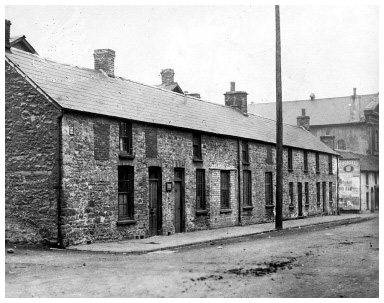 |
| Abernant House | |
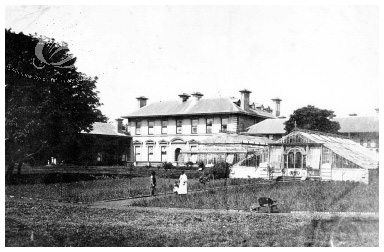 |
The original house at Abernant was built by James Birch, cofounder with Jeremiah Homfray of Abernant Ironworks. After the ironworks were sold in 1819 the house passed to Rowland Fothergill and later his nephew Richard Fothergill. Richard Fothergill was responsible for an ambitious scheme of work at the house, which included the construction of extensions to the main building and extensive landscaping of the grounds. Left: Abernant House |
In 1892 St Michael's Theological College was founded at Abernant House by Emma Talbot of Margam. The college opened on St David's Day 1892, with three students in the first term which rose to twelve students in the second term. The first warden was canon H R Johnson. In 1907 the college moved to Llandaff due to an insecurity of tenure at Abernant. Since 1917 Abernant House has been used as the site of Aberdare General Hospital. Right: This photograph of the Chapel at St Michael's College, illustrates the fine architectural details of the interior of Abernant House, that were destroyed in the fire of 1929. |
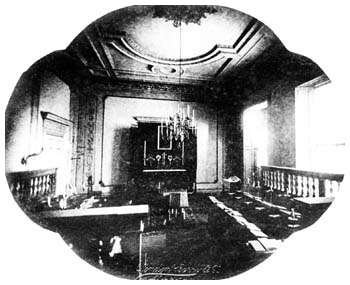 |
| The movement for a hospital began in 1907 and the initial site chosen was at Godreaman, but following delays an offer from the Marquis of Bute to lease Abernant House was taken up. Public donations raised £14,428 towards the cost of the hospital and the local coalowners contributed £10,000 The work of converting Abernant House was carried out by Horace J Davies of Bargoed at a cost of £10,300. On July 17th 1917 Aberdare General Hospital was opened. The hospital gradually expanded after its opening. Three acres on the south side of the hospital were presented by the Powell Duffryn Co. In 1920 an increase in the contributions made by the workmen of the district from 1d to 3d per week allowed an extension of the Ophthalmic and Orthopedic Wards. A new Convalescent Ward was opened in 1923 and Charles Kenshole purchased and presented to the hospital the whole of Abernant Park to the South. By 1927 the hospital owned all of the grounds which surrounded it, and a farm was established to supply fresh milk for the patients. |
|
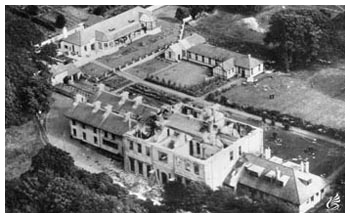 |
On September 27th 1929 a disastrous fire destroyed the main building, the former Abernant House . The fire gutted the interior of the building and all of the interior grandeur of Abernant House was destroyed. The hospital was reopened in April 1933 by HRH The Duchess of York (the later Queen Mother). The hospital continued to expand under patronage from local benefactors, in 1939 W M Llewellyn funded the construction of a new maternity ward. Left: This photograph shows the severe damage to Aberdare General Hospital caused by the fire of September 27th 1929 |
| Abernant Ironworks | |
Abernant ironworks was founded in 1801 when Jeremiah Homfray and James Birch leased land and mineral rights at Abernant y Wenallt. In 1804 Homfray and Birch were joined in the venture by James and Francis Tappenden of Kent. In 1807, by which time three furnaces had been constructed on the site, a disagreement arose amongst the partners over the tramroad the Tappendens had built to the Neath Canal. Homfray and Birch retired from the company over this disagreement leaving the Tappendens in sole control. However, it appears that the Tappendens had overstretched themselves and in 1814 were forced to sue for bankruptcy after losing a legal battle with the Neath Canal. In 1819 the Abernant ironworks were bought by the Aberdare Iron Company, who already owned the Aberdare Ironworks at Llwydcoed. |
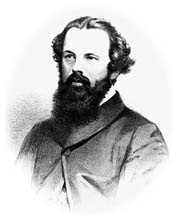 |
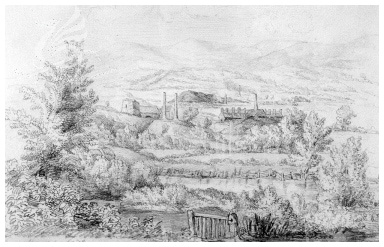 |
In 1823 three furnaces were operating at Abernant, but the ironworks had no facilities to refine their iron, which was sent to Merthyr Tydfil to be made into wrought iron bars. However, after Rowland Fothergill and his nephew Richard Fothergill took over the management of the works in 1846 they embarked on a period of modernisation. Abernant was chosen as the site for a forge and mills where the pig iron produced at Abernant and Llwydcoed could be refined. Left: Pencil drawing of Abernant dated September 1827 |
| River Level Colliery Disastar 1896 | |
On the 9th December 1896 the workings at the River Level Colliery, Abernant, were inundated by water from old workings at Ysguborwen Colliery. The water had broken through because shortly before the Ysguborwen Colliery was abandoned in December 1895, colliers at the mine had worked a 'skip' that encroached on old workings at the River Level Colliery. Therefore, without the knowledge of the colliers and managers of River Level Colliery, the barrier that had been left between No. 2 Heading of River Level and the Ysguborwen workings had been fatally weakened. When the drain level at Ysguborwen, a notoriously 'wet' colliery, became blocked by a fall, the water burst through to the River Level Colliery workings. |
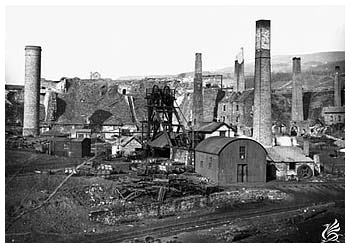 |
| It became apparent at the later inquest that colliers at Ysguborwen had actually broken through to the River Level Colliery, but no action was taken to warn the management of that colliery of the possible danger. A report by the barrister Robert Woodfall found the blame to lie with the managers at Ysguborwen Colliery and exonerated all those at River Level Colliery of any wrongdoing. He felt, however, that it would be difficult to secure a conviction "because the recklessness shown is so common in mining." Six men of the 120 working at River Level Colliery lost their lives. They were Thomas Jones (29); John Phillips (39); father and son John Jenkins (52) and Thomas Jenkins (18); and the two boys George Evans (14) and John Williams (13). Their bodies were not recovered until 23rd December after the workings had been pumped clear of water and gas. The funeral was held on Christmas Day. A large procession formed at Abernant to escort the coffins of the victims to Aberdare Cemetery. A reporter on the South Wales Daily News estimated that when the procession reached Aberdare Town it already numbered between 2,000 - 3,000 people and was over a mile long. This number increased as more joined the procession as it moved through Trecynon to the Cemetery. In addition, spectators, who were nine to twelve deep in places, lined the route of the procession. |
|